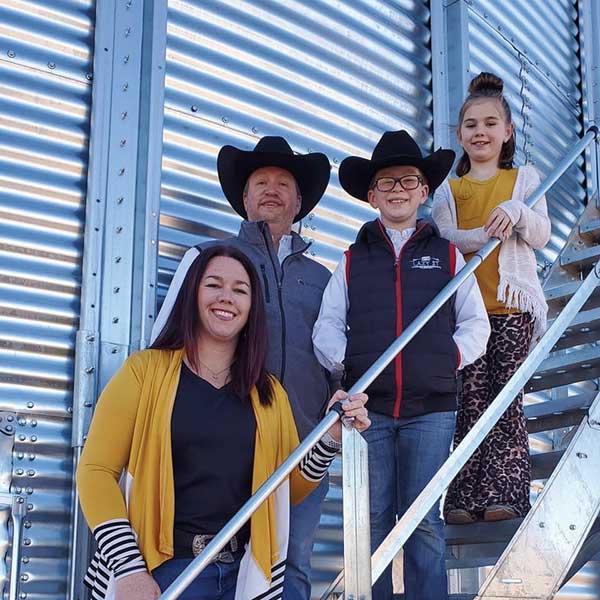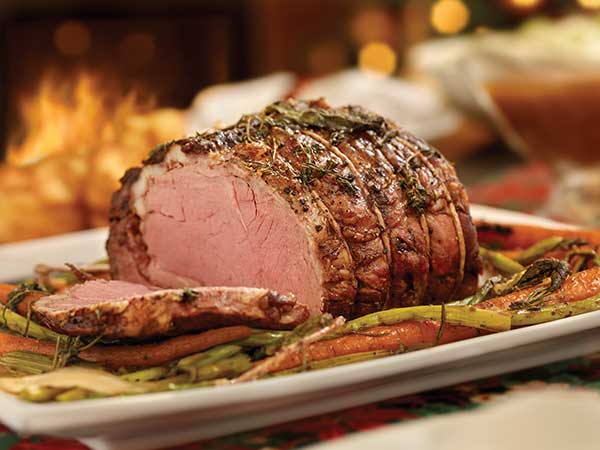Sustainable Family Meals from Farm to Table
(Family Features) Much time is often spent planning and preparing family meals, from choosing recipes to gathering ingredients and working in the kitchen. However, where that food actually comes from and how it’s made is an often-overlooked part of food preparation.
Next time you lay out a weekly menu that includes recipes like this Bone-In Prime Rib, keep sustainability in mind by considering the practices put in place by America’s farmers. For example, the corn industry’s evolution in sustainability along with its documented environmental, economic and social improvements over the last several decades points to farmers’ willingness to embrace change.
As the largest sector in American agriculture, corn farmers impact hundreds of thousands of jobs, infuse billions of dollars into the economy and care for critical resources while overseeing substantial improvements in production.
 The family farm belonging to Nathan and Nicki Weathers in Yuma, Colorado, includes 3,000 acres of irrigated crops and 300 cows. They harvest grain corn, which goes to a feedyard, dairy or an ethanol plant, and silage, which is sold to local feedyards.
The family farm belonging to Nathan and Nicki Weathers in Yuma, Colorado, includes 3,000 acres of irrigated crops and 300 cows. They harvest grain corn, which goes to a feedyard, dairy or an ethanol plant, and silage, which is sold to local feedyards.
According to Nathan, corn is the best feed available for his farm and makes his beef production more sustainable.
“They go hand in hand,” Nathan said. “To be able to drive the protein market and meet the demands of the future, we have to be sustainable in both. We need to have protein and be able to grow it and have a feed source for pork and poultry. Corn is an efficient and economic feed source for all our protein.”
Consider these ways the corn industry is continuing its efforts toward sustainable practices, according to the National Corn Growers Association’s Sustainability Report.
Soil Conservation
Healthy soils are the foundation of agriculture production and why corn farmers are committed to leaving land in better shape than they found it. Adoptions in conservation tillage and other soil conservation strategies have contributed to a reduction in erosion.
Water Stewardship
Farmers recognize the invaluable role water plays in raising crops each year. They also know they must actively protect this resource for the benefit of their crops, their communities and the planet.
Ecosystem Resilience
With approximately 90 million acres planted annually, corn is grown in a variety of ecosystems. Supporting the health of those ecosystems requires active attention from farmers, who respond by using integrated pest management techniques, establishing wildlife habitats on their lands and more.
Energy Efficiency
Technology that enhances farmers’ productivity also help reduce the amount of energy and emissions required for corn production. Farmers provide a carbon reduction strategy through the production of ethanol and the support of the Renewable Fuel Standard, a program created by Congress intended to reduce greenhouse gas emissions and expand the nation’s renewable fuels sector while reducing reliance on imported oil.
Minimal Waste
Due to corn’s versatility, from animal feed to ethanol production and bioplastics, the components of each kernel find homes in a variety of uses, leaving little to go to waste.
Find more information at ColoradoCorn.com.

Bone-In Prime Rib
Recipe courtesy of chef Jason K. Morse, C.E.C., 5280 Culinary, LLC, and Ace Hardware Grill Expert on behalf of the Colorado Corn Administrative Committee
- 1 bone-in prime rib roast (8 pounds)
- oil
- 5280 Culinary Rub-a-Dub seasoning, to taste
- 5280 Culinary Island Boys Coffee seasoning, to taste
- Remove roast from packaging and place on large sheet pan. Drain juices and warm at room temperature 20 minutes. Starting at tail on bone side of roast, cut bone along ribs, between meat and ribs, to back side, separating bones from meat.
- Rub prime rib with light coat of oil. Season on all sides and under bone with blend of seasonings. Return bones to bottom side and, using butcher twine, secure in 2-3 areas by tying bones to meat. Wrap in plastic wrap or place in pan and refrigerate 12-16 hours.
- Preheat smoker or grill to 200 F and load with preferred smoking wood chunks, if desired.
- Place prime rib on grill rib side down, fat side up, allowing drippings to collect in drip tray. Increase heat to 350 F. Close lid and cook, uncovered, until desired doneness is reached.
Photo courtesy of Getty Images (Bone-In Prime Rib)
Eat Like a Farmer
(Family Features) Farmers are the experts when it comes to enjoying the fruits of the land in the best way possible. Learn to eat like a farmer, and your taste buds will be sure to thank you later.
Across the United States, farmers are working hard to bring high-quality foods from their fields and groves to grocery store shelves and, ultimately, to your pantry. Sometimes foods you may not even think about coming from a farm have been grown with the most tender, loving care.
One example is olives, which are typically bought in cans, far removed from the produce section people more typically associate with farms. In California, hard-working, multi-generational farming families produce more than 95 percent of the olives grown and consumed in the United States. The farms – groves, to be exact – are home to thousands of trees that bear olive fruit for harvest each fall.
It should come as no surprise that these families have fine-tuned some of the most appetizing olive recipes by passing them on from one generation to the next. These farmers don’t just grow olives, they cook with them too, and are sharing some of their favorite recipes – from snacks to salads and pasta – using California Ripe Olives.
Find more California olive farmer-approved recipes at CalOlive.org.

Cowboy Caviar
Recipe courtesy of olive grower Natalie Jameson
Servings: 8-10
- 2 cups chopped tomato
- 3 green onions, sliced
- 1 avocado, peeled, pitted and cut into small cubes
- 1 can (15 ounces) black beans, rinsed and drained
- 1 can (6 ounces) large California Ripe Olives, drained and coarsely chopped
- 1/2 cup prepared vinaigrette dressing
- corn chips
- In medium bowl, stir together tomato, green onions, avocado, black beans and olives.
- Toss with dressing and serve with corn chips.

Rotini with Shrimp and Olives
Recipe courtesy of olive grower Pablo Nerey
Servings: 6-8
- 1 pound rotini pasta
- 2 tablespoons butter
- 2 tablespoons olive oil
- 3 tablespoons chopped garlic
- 1 pound large shrimp, peeled and deveined
- 1/2 teaspoon garlic salt
- pepper, to taste
- 1 cup heavy cream
- 1/2 cup grated Parmesan cheese, plus extra for garnish
- 2 tablespoons prepared pesto
- 1 can (2.25 ounces) sliced California Ripe Olives
- Bring large pot of lightly salted water to a boil. Add pasta and cook 8-10 minutes, or until al dente; drain well and set aside.
- In large skillet, heat butter and olive oil over medium heat.
- Add garlic and stir until golden, being careful not to burn.
- Add shrimp to skillet and season with garlic salt and pepper. Cook about 5 minutes, or until shrimp are pink, stirring frequently.
- Reduce heat to medium-low and add cream to skillet; simmer until thick.
- Add cooked pasta to sauce and stir in Parmesan cheese, pesto and olives.
- Sprinkle with Parmesan cheese.

Red Potato and Olive Salad
Recipe courtesy of olive grower Carolina Burreson
Servings: 4-6
Dressing
- 1/2 cup olive oil
- 3 tablespoons lemon juice
- 2 tablespoons red wine vinegar
- 1/2 teaspoon ground pepper
- 1/2 teaspoon kosher salt
- 1/4 teaspoon sugar
Salad
- 1/2 cup sliced California Ripe Olives, drained
- 1/2 cup grape tomatoes, halved
- 1/4 cup chopped fresh Italian parsley
- 1/4 cup chopped celery
- 1 1/2 pounds small red potatoes, quartered and boiled until tender
- 1 jar (6 ounces) marinated artichoke hearts, drained and coarsely chopped
- 1/4 medium red onion, thinly sliced
- In sealable jar, mix together dressing ingredients and refrigerate at least 4 hours.
- When ready to serve, place all salad ingredients in large bowl. Drizzle with dressing and toss lightly to coat.
Source: California Olive Committee


